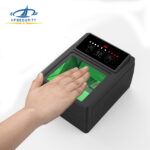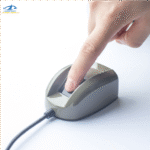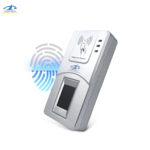What Is a Fingerprint Scanner?
UN scanner d'empreintes digitales is a biometric device that captures and analyzes the unique patterns of ridges and valleys on a person’s fingertip. Since no two fingerprints are exactly the same, this technology provides a secure and reliable way to identify individuals.
How Does a Fingerprint Scanner Work?
The basic working process of a fingerprint scanner involves the following steps:
| Step | Fonction |
|---|---|
| 1. Image Capture | The scanner captures a fingerprint image using a sensor. |
| 2. Image Processing | The system processes the image to enhance clarity and extract unique features. |
| 3. Feature Extraction | Specific patterns such as ridges, minutiae points, and loops are identified. |
| 4. Matching | The scanned fingerprint is compared to stored templates in the database. |
| 5. Authentication Result | The system grants or denies access based on the match result. |
Types de scanners d'empreintes digitales
1. Optical Fingerprint Scanner
An optical fingerprint scanner captures a visual image of the fingerprint using light. When a finger is placed on the scanner, a light source illuminates the skin, and a CMOS or CCD sensor records the fingerprint’s ridges and valleys based on light and dark patterns.
This method is widely used in time attendance systems, access control devices, and entry-level biometric products due to its affordability.
However, it can be less accurate in conditions where the finger is dirty, oily, or wet and is more vulnerable to spoofing with fake fingerprints.
2. Capacitive (Touch) Fingerprint Scanner
Capacitive fingerprint scanners use electrical charge differences to map the fingerprint. Instead of capturing a light-based image, they detect the ridges and valleys of the fingerprint by measuring the electrical capacity at each point of contact.
This method offers higher accuracy and stronger resistance to fake fingerprints compared to optical scanners.
Capacitive sensors are commonly used in smartphones, laptops, and secure authentication devices. They are reliable and difficult to fool with 2D fingerprint replicas.
3. Ultrasonic Fingerprint Scanner
Ultrasonic fingerprint scanners use high-frequency sound waves to penetrate the outer layers of the skin and capture detailed 3D data of the fingerprint.
This technique measures both surface and subsurface characteristics, making it highly accurate even with moisture, dirt, or slight skin damage.
It is widely used in high-security applications, including advanced smartphones, military-grade equipment, and government ID systems.
Ultrasonic scanners provide robust anti-spoofing capabilities and enhanced security.
4. Thermal Fingerprint Scanner
Thermal fingerprint scanners detect the natural heat emitted by a fingertip. When a finger touches the sensor, the ridges transfer more heat than the valleys, allowing the scanner to build a thermal image of the fingerprint.
These scanners are less common but can be useful in specific environments, such as outdoor or rugged conditions where other types might fail.
They are less affected by light or electric interference but may have slower processing times and limited resolution compared to capacitive or ultrasonic types.
Benefits of Fingerprint Scanner Technology
Using fingerprint scanners brings numerous benefits, including:
Haute précision
Fingerprints are biologically unique and difficult to replicate. With advanced recognition algorithms, fingerprint systems deliver highly accurate identity verification with minimal false positives, making them ideal for security-sensitive applications.
User Convenience
Fingerprint access is quick, contact-based, and easy to use. It removes the hassle of remembering passwords or carrying access cards, offering a seamless experience for employees, visitors, and users across various industries.
Sécurité renforcée
Only registered fingerprints are granted access, preventing unauthorized entry. This biometric layer adds strong security to doors, systems, or sensitive areas, effectively reducing risks of theft or identity fraud.
Rentable
Once installed, fingerprint systems reduce expenses on lost cards, forgotten passwords, or key replacements. They also streamline access management, saving both time and administrative costs in the long run.
Where Are Fingerprint Scanners Used?
Fingerprint scanners are widely adopted in many industries:
Mobile Phones (Biometric Unlocking)
Fingerprint or facial recognition allows users to unlock phones instantly and securely, replacing PINs and patterns with fast, convenient biometric access.
Banking and Finance (Secure Customer Verification)
Biometric authentication adds a strong layer of identity protection for online banking, mobile payments, and ATM access, reducing fraud and identity theft.
Government and Law Enforcement (Criminal Identification)
Biometrics are used for verifying identities, tracking suspects, and managing national ID programs with high accuracy and fast results.
Corporate Offices (Employee Attendance Systems)
Fingerprint or face recognition ensures accurate time tracking, prevents buddy punching, and simplifies attendance management for HR departments.
Access Control Systems (Secure Building Entry)
Only authorized personnel can enter secured zones, improving physical security for offices, data centers, labs, and restricted areas.
How Fingerprint Scanners Improve Access Control
In modern security systems, fingerprint scanners serve as a reliable biometric method for contrôle d'accès. They can be integrated with turnstiles, gates, or smart locks, ensuring only authorized individuals can enter restricted areas. The real-time verification and audit logs also support accountability and monitoring.
FAQ
Yes, fingerprint scanners are generally safe and store fingerprint data as encrypted templates, not raw images.
Advanced scanners use liveness detection to prevent spoofing with fake fingers or images.
No, different technologies (optical, capacitive, ultrasonic) use different methods to scan and interpret fingerprints.
Some high-end scanners can still detect fingerprints, but it's best to keep fingers clean for optimal accuracy.
Conclusion
Now that you know how a scanner d'empreintes digitales works, it’s easy to see why this technology is becoming an essential part of modern security solutions. Whether for personal use or enterprise-level deployment, fingerprint scanners offer a seamless blend of security, efficiency, and biometric innovation.







